10 Data Orchestration Tools: Features Guide 2024
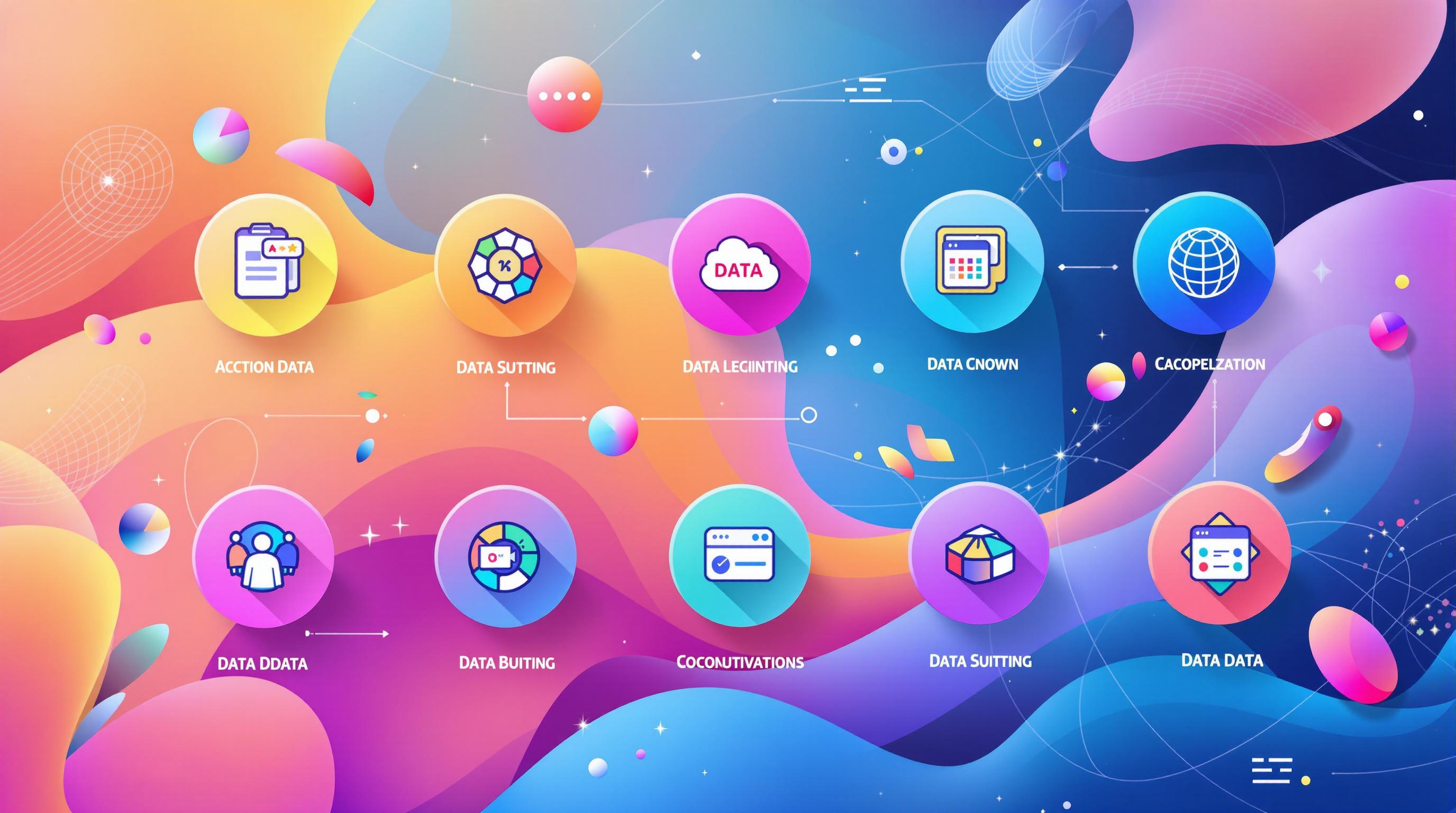
Looking for the best data orchestration tools in 2024? Here's a quick rundown of the top 10:
- Apache Airflow - Open-source powerhouse for complex workflows
- Prefect - Flexible Python-based tool with error handling
- Dagster - Asset-centric approach with built-in testing
- Azure Data Factory - Microsoft's cloud-based integration service
- AWS Glue - Amazon's serverless ETL offering
- Google Cloud Composer - Managed Airflow service on Google Cloud
- Databricks - Unified analytics platform with AI integration
- Endgrate - Single API for 100+ third-party integrations
- Astronomer - Enterprise-grade Airflow as a managed service
- Keboola - All-in-one platform with 700+ integrations
These tools help businesses streamline data workflows, automate tasks, and unlock insights faster. They range from open-source options to fully managed services, catering to various needs and skill levels.
Key benefits include:
- Reduced manual work
- Improved data quality
- Faster insights
- Better scalability
- Enhanced compliance
When choosing a tool, consider your team's skills, data volume, existing tech stack, and future AI/ML needs.
Quick Comparison:
| Tool | Open Source | Cloud Native | AI/ML Support | No-Code Interface |
|---|---|---|---|---|
| Apache Airflow | Yes | No | Limited | No |
| Prefect | Yes | Yes | Yes | Limited |
| Dagster | Yes | Yes | Yes | No |
| Azure Data Factory | No | Yes | Yes | Yes |
| AWS Glue | No | Yes | Yes | Limited |
| Google Cloud Composer | No | Yes | Yes | No |
| Databricks | No | Yes | Strong | Limited |
| Endgrate | No | Yes | No | Yes |
| Astronomer | No | Yes | Yes | No |
| Keboola | No | Yes | Yes | Yes |
Related video from YouTube
1. Apache Airflow
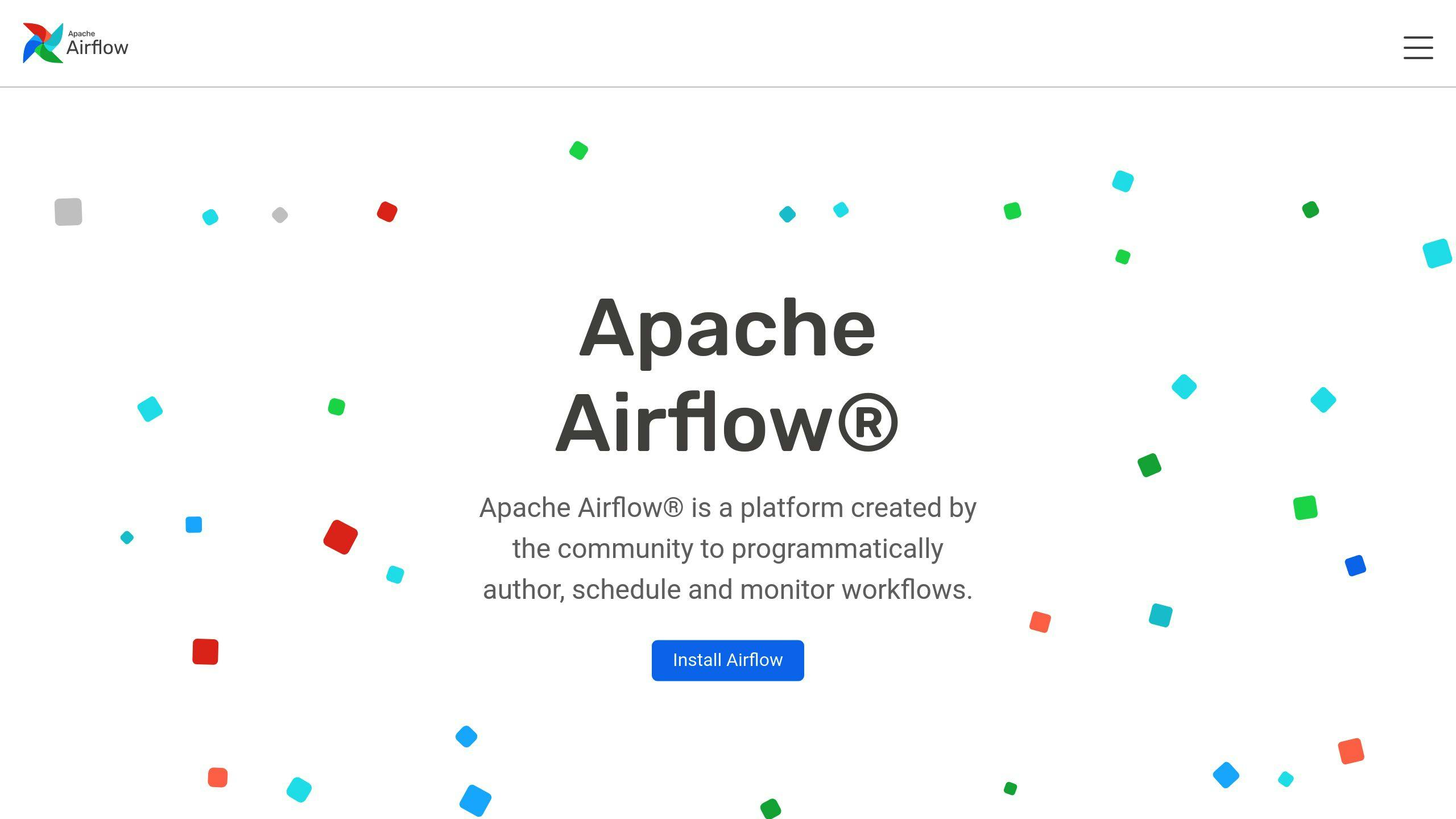
Apache Airflow is a powerhouse for data orchestration. It's the go-to tool for managing complex data pipelines. Airbnb created it to streamline their workflows, and now it's an open-source giant under the Apache Software Foundation.
Airflow's secret sauce? Directed Acyclic Graphs (DAGs). Think of them as a series of tasks that need to happen in a specific order. You write these DAGs in Python, so you can make them as simple or complex as you need.
Airflow can handle BIG workloads. Just ask Shopify - they're running over 10,000 DAGs with about 400 tasks going at once. That's a lot of data crunching!
The latest version, 2.10.0, brings some cool new features:
- Multiple executor configuration: Use different executors for various tasks in one environment. It's like having a Swiss Army knife for your data pipelines.
-
Dynamic dataset scheduling: The new
DatasetAliasclass makes your pipelines more flexible. Your workflows can adapt on the fly to data changes. - Dark mode UI: Late-night debugging just got easier on the eyes.
But it's not all smooth sailing. Shopify hit some bumps when scaling up:
"A combination of GCS and NFS allows for both performant and easy to use file management."
They had issues with slow file access using Google Cloud Storage (GCS) and GCSFuse. The fix? Running an NFS server in their Kubernetes cluster. This hybrid approach gave them fast file access and quick DAG file updates.
Pro tip: Watch your metadata. Shopify found that a 28-day retention policy kept their database manageable without losing recent troubleshooting info.
Airflow's web-based UI is like a mission control for your data pipelines. You can see your DAGs, task durations, failures, and retries at a glance.
Setting up Airflow is easy. Install Python, set up an Airflow home directory, and run the Airflow standalone command. You're ready to build workflows.
Airflow works best with pipelines that don't change much and can be triggered manually or externally. It's not great for real-time streaming or workflows that need constant changes.
In the world of data orchestration, Airflow is still a top pick for businesses of all sizes. Its flexibility, scalability, and strong open-source community make it a solid choice for building robust data pipelines in 2024 and beyond.
2. Prefect
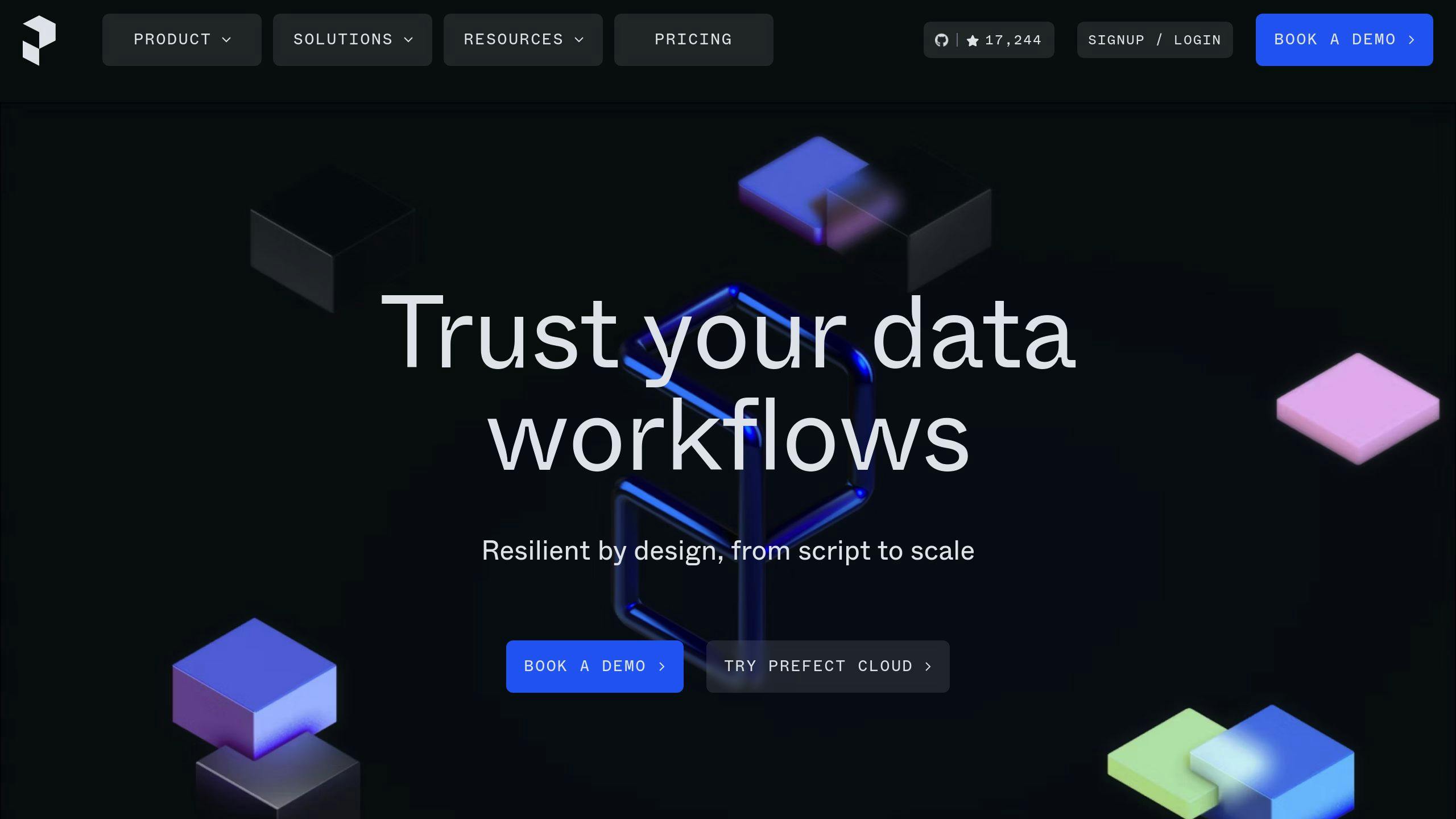
Prefect is shaking up data orchestration. It's the new kid on the block, making data pipeline automation a breeze for engineers and scientists.
What's the big deal? Prefect lets you write workflows as Python functions. No more rigid structures. Your pipelines can adapt on the fly.
But here's where it gets interesting:
Prefect handles curveballs like a pro. Pipeline hit a snag? No problem. Set up custom retries or reroute your workflow mid-stream. It's like having a data pipeline with a built-in GPS.
Take the Washington Nationals. They're using Prefect to juggle data from multiple APIs. Their data scientists love it. Why? They can spot errors AND set up auto-fixes. It's like having a virtual groundskeeper for their data field.
The user interface? It's a breath of fresh air. Clean, modern, and gives you a bird's-eye view of your workflows. Track dependencies, spot bottlenecks, see task durations - all at a glance. For teams drowning in complexity, this visibility is a game-changer.
Getting started is a piece of cake. Install with pip, use the @flow decorator, and you're off to the races. Here's a taste:
from prefect import flow, task
@task
def fetch_data():
return "Data fetched!"
@task
def process_data(data):
return f"Processed: {data}"
@flow
def my_first_flow():
data = fetch_data()
result = process_data(data)
print(result)
my_first_flow()
Simple, right? That's why big names like Slate, Kaggle, and Microsoft are jumping on board.
But Prefect isn't just about writing code. It's about making your entire pipeline smarter. Take intelligent caching. It skips tasks when inputs haven't changed, saving time and resources. It's like your pipeline suddenly grew a brain.
Jeremiah Lowin, Prefect's founder and CEO, puts it this way: "We want people and businesses to use our software with the least friction possible." That philosophy shines through in every feature.
Need to scale? Prefect's got you covered with self-hosted options and a cloud service. Start with the free tier, then ramp up as you grow.
In the data orchestration world, Prefect is your Swiss Army knife. Whether you're scraping the web, running ML pipelines, or juggling complex ETL processes, Prefect keeps your data flowing smooth as silk.
3. Dagster
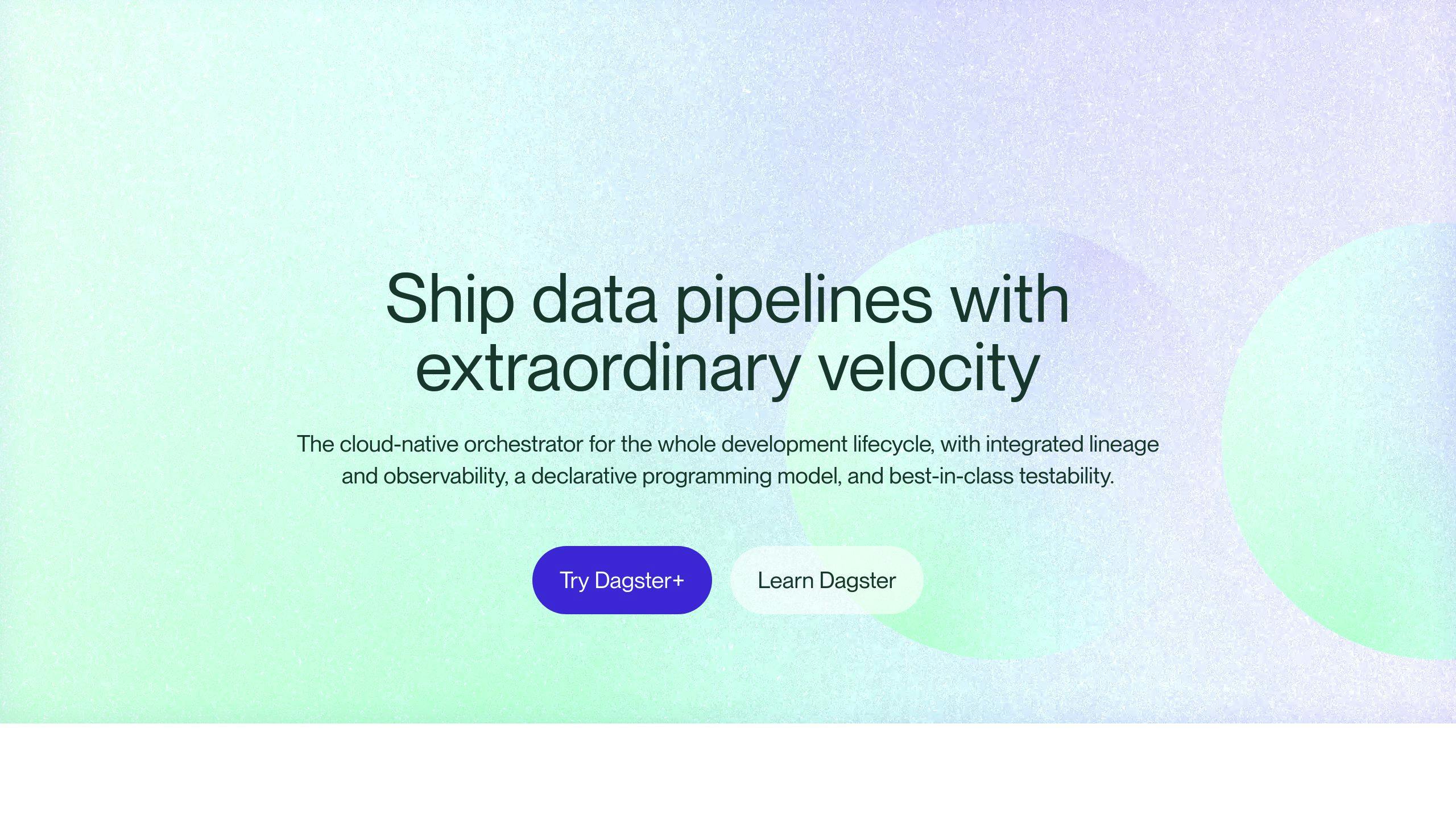
Dagster is shaking up data orchestration with its fresh take on managing complex workflows. It's not just about running tasks - Dagster looks at the whole data lifecycle.
The big idea? Software-defined assets (SDAs). These are like LEGO blocks for your data pipeline. Instead of just listing steps, you're mapping out the actual data products you're building. It's a whole new way of thinking about data flows.
Nick Schrock, who created Dagster and GraphQL, puts it this way:
"Dagster introduces a new primitive: a data-aware, typed, self-describing, logical orchestration graph."
This approach is working wonders for companies like BenchSci. After switching to Dagster, they could see their data dependencies clear as day. Result? Faster debugging and quicker development.
SimpliSafe, the home security folks, jumped on board too. They cleaned up their data processes and built more reliable pipelines. It's like going from a tangled mess of wires to a neat control panel.
Here's what makes Dagster special:
- It has built-in testing. No more hoping your pipeline works - you can check it.
- You can run it anywhere: locally, in CI/CD, or in production.
- It has a powerful UI called Dagit. It's like a command center for your data.
- It plays well with others, like dbt, Spark, and MLflow.
For data teams drowning in complexity, Dagster is a lifesaver. It's not just about moving data around - it's about understanding and managing your data assets from start to finish.
Sandy Ryza, Lead Engineer at Dagster, explains:
"Instead of describing the chaos that exists, SDA declares the order you want to create. Once you've declared this order you want to create, an asset-based orchestrator helps you materialize and maintain it."
In other words, you tell Dagster what you want your data to look like, and it figures out how to make it happen. It's like GPS for your data.
Getting started is easy. Here's a basic software-defined asset in Python:
@asset
def my_first_asset():
return "Hello, Dagster!"
From there, you can build complex pipelines, set schedules, and keep an eye on everything through Dagit.
If you're battling data quality issues or want to speed up development, Dagster might be your answer. It's not just about moving data - it's about optimizing your whole data ecosystem.
As we head into 2024, Dagster is making waves in data orchestration. Its focus on data quality, testing, and analytics makes it a top pick for companies looking to level up their data game.
4. Azure Data Factory
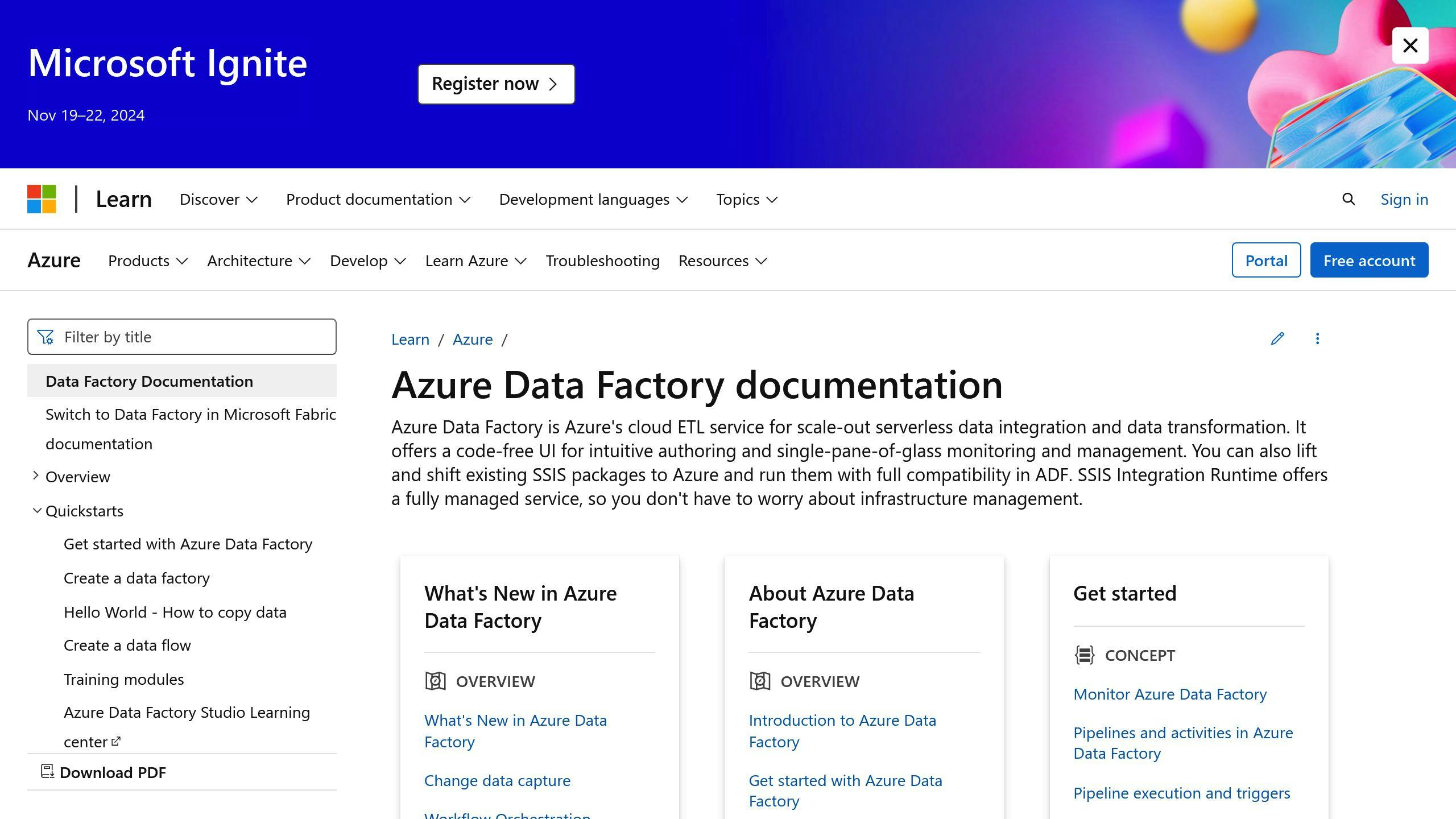
Azure Data Factory (ADF) is Microsoft's cloud-based data integration tool. It's designed to handle data from various sources, transform it, and move it where it needs to go.
ADF's strength? Scale and flexibility. It works for small startups and big corporations alike. Think of it as a Swiss Army knife for data orchestration.
Here's what makes ADF stand out:
- Supports over 90 built-in connectors
- Pulls data from almost anywhere (on-premises databases, cloud services, SaaS apps)
- Powerful data transformation capabilities
The Mapping Data Flows feature lets you design complex data transformations visually - no coding required. In 2024, it's even better. Microsoft upgraded it to use Spark 3.3, meaning faster processing and better scalability.
"Azure Data Factory is a powerful data integration service that simplifies the process of ingesting, transforming, and orchestrating data from various sources."
Real-world examples:
- A major retailer used ADF to integrate data from multiple sources, including on-premises SQL Server databases and Azure SQL Databases. They created pipelines that moved this data into a centralized Azure Data Lake for business intelligence and reporting.
- A financial services company uses ADF to move and transform massive amounts of data into Azure Synapse Analytics. This lets them run advanced analytics and machine learning models for insights into market trends and customer preferences.
Practical tips for using ADF:
- Use regional orchestration resources for maximum pipeline execution parallelism.
- Use Self Hosted Integration Runtimes (IRs) as multi-node clusters for load balancing and failover.
- Always use Managed Identities for security when writing data to storage.
ADF shines in hybrid data integration. Got data spread across on-premises systems and various cloud platforms? ADF can bring it all together.
The visual interface makes it easy to design and monitor data pipelines. With Git integration and CI/CD support, it fits into modern DevOps practices.
In 2024, ADF continues to evolve. Microsoft has expanded its regional availability and raised the pipeline activity limit to 80, allowing for more complex data integration processes.
For companies looking to make the most of their data in 2024 and beyond, Azure Data Factory is a top choice. Its mix of power, flexibility, and ease of use makes it a standout in the world of data orchestration.
5. AWS Glue
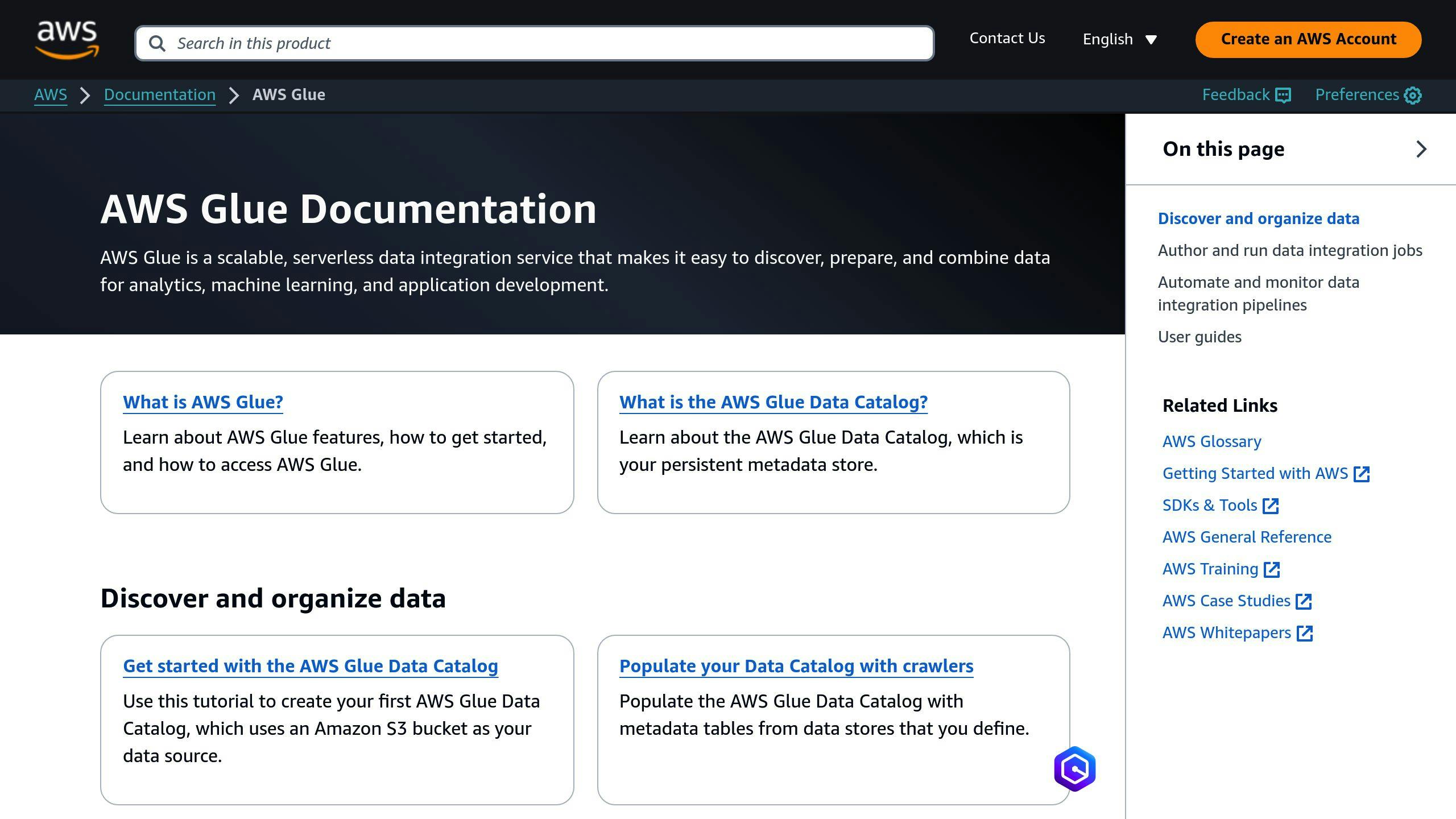
AWS Glue is Amazon's serverless data integration service. It's a fully managed ETL (Extract, Transform, Load) tool that simplifies data prep and loading for analytics.
What's the big deal? AWS Glue handles the backend stuff. No servers or clusters to worry about. You just focus on your data.
Here's something cool: AWS Glue automatically finds and catalogs your metadata from different sources. It's like having a data detective working 24/7.
In 2024, AWS Glue got even better. They added 13 new built-in transforms, including:
- Spotting duplicate columns
- Formatting phone numbers
- Encrypting and decrypting data
- Converting IP addresses to integers (and back)
These new features are a big win for ETL developers. They can now build complex pipelines with just a few clicks, instead of writing custom code for every little thing.
But it's not just about fancy features. AWS Glue shines in real-world use. Check out this example from a big retailer:
"AWS Glue helped us bring data from our on-premises SQL Server databases and Azure SQL Databases into one central Azure Data Lake. This totally changed our business intelligence and reporting game."
The retailer's team built complex data pipelines without managing any infrastructure. That's the magic of serverless.
If you're new to AWS Glue, here are some tips:
- Use regional orchestration resources for max pipeline parallelism.
- Set up Self Hosted Integration Runtimes (IRs) as multi-node clusters for load balancing and failover.
- Always use Managed Identities for security when writing data to storage.
AWS Glue's pricing is pretty sweet too. You pay by the second, with a 1-minute minimum for most jobs. This can save you a bunch, especially on shorter tasks.
Here's a quick price breakdown:
| Job Type | Price per DPU-Hour | Minimum Billing |
|---|---|---|
| Apache Spark | $0.44 | 1 minute |
| Spark Streaming | $0.44 | 1 minute |
| Python Shell | $0.44 | 1 minute |
| Ray (Preview) | $0.44 per M-DPU-Hour | 1 minute |
A standard DPU gives you 4 vCPU and 16 GB of memory. Need more RAM? Go for high-memory DPUs (M-DPUs) with double the memory.
AWS Glue isn't just about ETL, though. It's becoming a key player in modern data stacks. It works great with other AWS services like Lake Formation, making it a powerful tool for managing data lakes.
As we roll through 2024, AWS Glue is proving to be a solid choice for all kinds of businesses. Whether you're a small startup or a big enterprise, AWS Glue offers a mix of simplicity, power, and flexibility that's hard to beat.
sbb-itb-96038d7
6. Google Cloud Composer
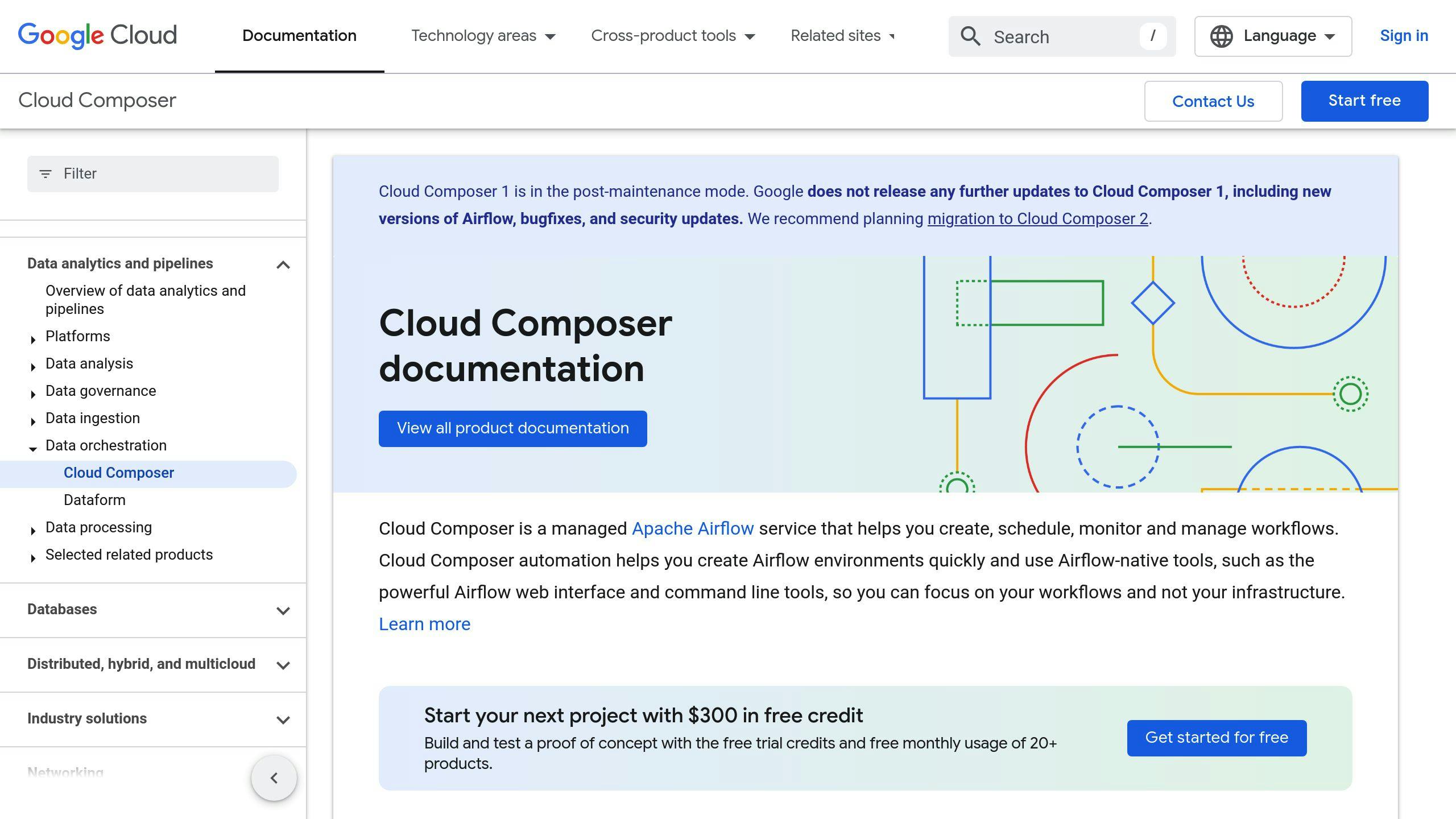
Google Cloud Composer is a managed workflow orchestration service built on Apache Airflow. It's designed to simplify data pipeline management in the Google Cloud ecosystem.
Here's what makes Cloud Composer tick:
GCP Integration: Cloud Composer works seamlessly with other Google Cloud services like BigQuery and Cloud Storage. This integration is a big plus for teams already using Google Cloud.
Scalability: Cloud Composer uses Kubernetes for autoscaling. This means your workflows can handle sudden workload increases without issues. One user scaled from 100 to 1000 concurrent tasks in minutes.
Open-Source Base: Built on Apache Airflow, Cloud Composer combines open-source flexibility with managed service reliability. You get access to a wide range of plugins and connectors.
But it's not perfect. Some users have faced scaling challenges, especially with multiple concurrent tasks. The fix? Proper configuration. Here's a tip from a Google Cloud Engineer:
"To achieve autoscaling, ensure that the worker is configured as a Deployment type rather than a Pod type."
Setting up Cloud Composer is straightforward, but keep these points in mind:
1. Machine Selection
The default machine type (n1-standard-1 with 1 CPU and 3.75 GB memory) might not be enough for complex workflows. Upgrade if you hit performance issues.
2. Memory Management
Each airflow-worker pod needs about 2.5 GB of memory. Factor this in when planning your cluster size.
3. Autoscaling Setup
For node-level autoscaling, use the Google Cloud Console or gcloud CLI to set min and max nodes. For worker-level scaling, apply Kubernetes' Horizontal Pod Autoscaler to the airflow-worker Deployment.
4. Airflow Parameters
Adjust Airflow settings to prevent bottlenecks. Try setting parallelism to 300 and matching dag_concurrency to this value.
Cloud Composer shines in real-world use. A data engineer shared:
"After multiple false starts and hours of frustration attempting local and VM installations, I've determined the easiest way to run Airflow is on GCP."
This view is common in the industry. Cloud Composer simplifies Airflow management, letting you focus on building data pipelines instead of managing infrastructure.
As of 2024, Cloud Composer keeps evolving. Google regularly updates it with new Airflow versions and features. The latest environments can use composer-2.0.17-airflow-2.2.5, improving performance and functionality.
In the data orchestration world, Cloud Composer stands out as a robust, scalable solution. It's not just about running Airflow, but running it efficiently at scale. For teams wanting to streamline data workflows without managing infrastructure, Cloud Composer is worth considering.
7. Databricks
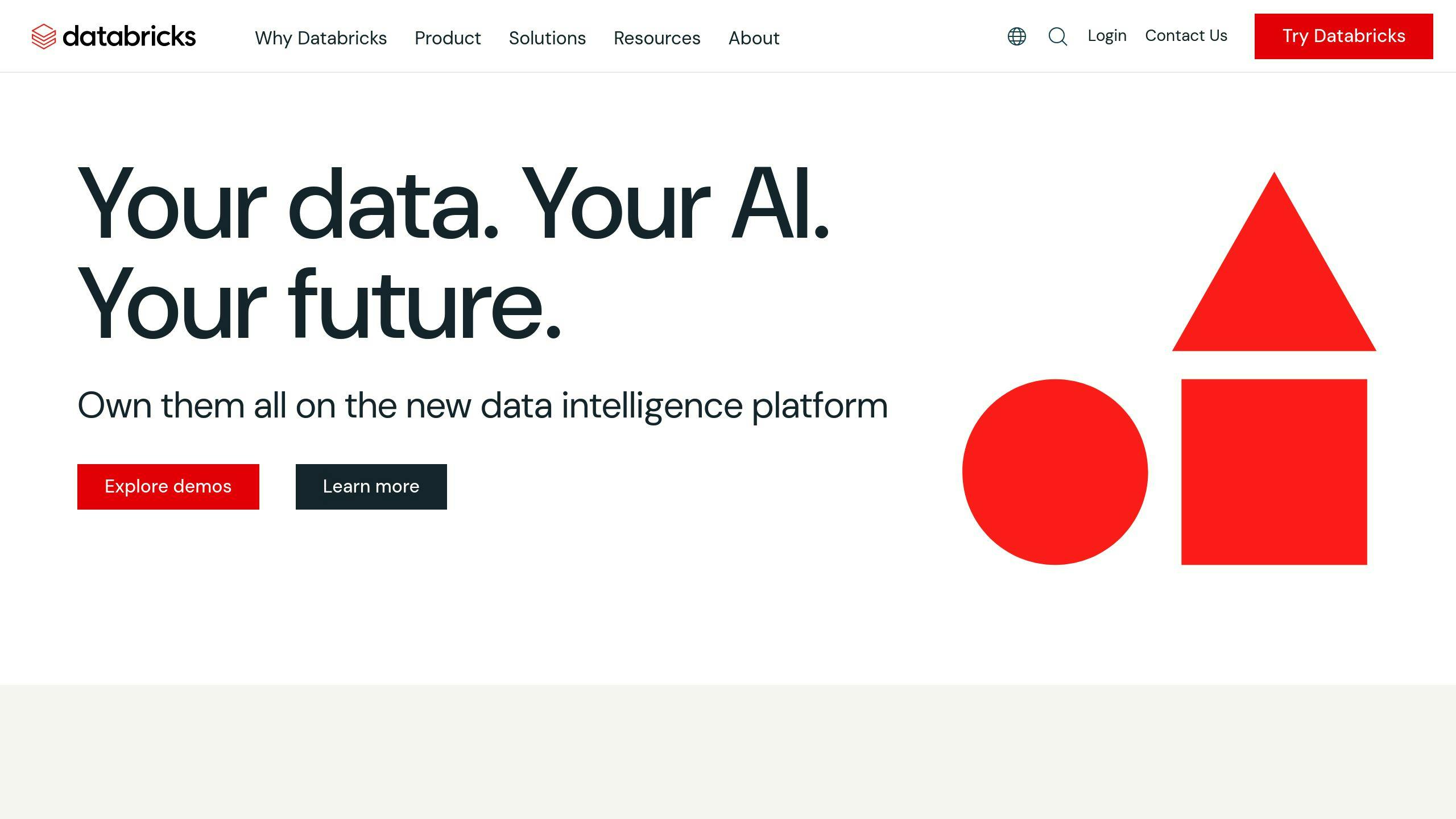
Databricks is shaking up the data world with its Data Intelligence Platform. It's not just another tool - it's a one-stop shop for data engineering, science, and machine learning.
What's the big deal? Databricks makes data access and AI development a whole lot easier. Here's how:
- Data Engineering Powerhouse: Databricks uses Apache Spark, Delta Lake, and Delta Live Tables to make ETL processes smooth as butter. No wonder Forrester named them a leader in cloud data pipelines.
- Real-Time Data Handling: Thanks to their Arcion acquisition, Databricks can now ingest and analyze data in real-time from all sorts of sources. If you're dealing with time-sensitive data, this is huge.
- Delta Live Tables (DLT): This feature is a game-changer for ETL. Instead of juggling complex pipelines, you just define transformations, and DLT takes care of the rest. Talk about a time-saver!
- Append_flow API: This nifty feature lets you write multiple streams to a single table. No need for a full refresh every time - it's all about flexibility.
- Databricks Workflows: This orchestration engine can handle up to 1,000 tasks in a single job. Plus, it's got data-driven triggers. As one data engineer put it:
"Data-driven triggers in Databricks Workflows have been a game-changer for us. We can now initiate jobs precisely when new data becomes available, optimizing our resource consumption and ensuring timely insights."
- AI Integration: With unreliable data being the biggest AI headache for 3 out of 4 executives, Databricks' focus on marrying AI with solid data engineering is spot-on.
- Cloud Flexibility: Whether you're Team Azure or Team AWS, Databricks has got you covered. It even autoscales based on your workload.
Pooja Pandit, a data engineering guru, hits the nail on the head:
"Scaling a data pipeline is indeed more than just adding more computing power
Performance-wise, Databricks is no slouch. In a recent test, a Databricks workflow finished in about 7 minutes, costing just 3.5 cents per run. If you're running data jobs left and right, that efficiency adds up fast.
Looking ahead, Databricks isn't resting on its laurels. They've added over 70 new features to Workflows in the past year alone. Their focus? Making complex workflows clearer and more efficient.
8. Endgrate

Endgrate isn't your typical data orchestration tool. It's more like a Swiss Army knife for third-party integrations. How? By offering a single API that connects to over 100 different services.
Think about it: instead of juggling a dozen different APIs, you get one master key. Pretty neat, right?
Here's what makes Endgrate stand out:
- You can mold your data models like clay
- It fits into your workflow like a missing puzzle piece
- All your integrations are visible at a glance
- Need a new integration? Just add it on the fly
- Your data stays locked up tight with top-notch security
For companies drowning in data sources and third-party tools, Endgrate is a lifesaver. Developers can stop building separate bridges to each tool and just use Endgrate's universal connector.
Now, Endgrate isn't trying to replace heavy-hitters like Apache Airflow or Databricks. It's more like their helpful sidekick, making sure data flows smoothly between different services. This is gold for SaaS companies that need to play nice with a ton of customer tools.
Endgrate's pricing is flexible:
- Got a small team or flying solo? There's a free plan for that.
- Business on the up and up? Check out the Standard Plan.
- Big enterprise with complex needs? The Premium Plan's got you covered.
By taking the headache out of integrations, Endgrate lets data teams focus on the big picture. They can spend less time wrestling with APIs and more time building killer data pipelines.
In the grand scheme of data orchestration, think of Endgrate as the opening act. It sets the stage by making sure all your data sources are in harmony before the main event kicks off.
9. Astronomer
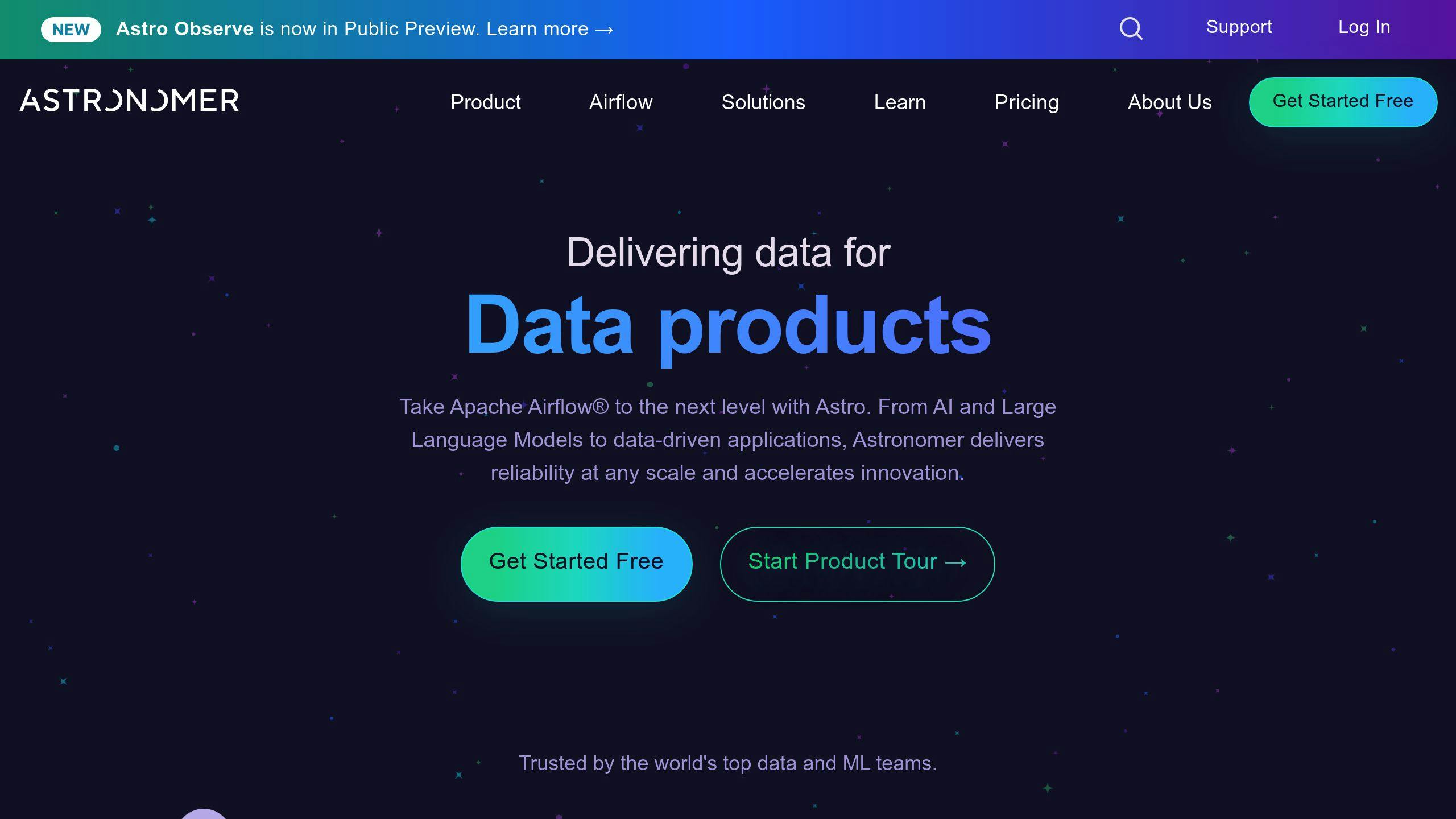
Astronomer is a data orchestration powerhouse. It's a managed platform built on Apache Airflow that simplifies data pipeline management while offering enterprise-grade features.
What makes Astronomer special?
Astro Runtime: It's not just about running Airflow - it's about running it efficiently at scale. Astro Runtime is built for the cloud, giving modern data teams a next-level experience.
Easy Scaling: Astronomer uses Amazon EKS to run Astro as a managed service. This means you can handle big workflows without needing to be a Kubernetes expert.
Tight Security: Astronomer takes data security seriously. They've built in compliance measures like role-based access control, audit logs, and Single Sign-On.
All-in-One Orchestration: Astronomer is expanding beyond Airflow to include dbt. This means teams can orchestrate both tools in a single pipeline - a big deal for many organizations.
But does it work in the real world? Just ask Molson Coors Beverage Company. Kevin Schmidt, their Sr Manager of Data Engineering, says:
"Using Astro's Apache Airflow® offering on Azure has modernized our data operations. Their best-in-class SLAs, multi-environment deployments, and intuitive dashboards have streamlined our processes, ensuring we can manage our critical pipelines."
Astronomer isn't just about running workflows. They've also introduced Astro Observe, a tool that gives you a bird's-eye view of your entire data supply chain. This helps teams spot optimization opportunities and fix issues fast.
And the numbers? They're pretty impressive:
- 438% ROI in less than 6 months
- 75% less time spent on infrastructure management
- Start building data pipelines in under 5 minutes
But Astronomer isn't just resting on its laurels. They're actively shaping the future of data orchestration. Their 2024 State of Apache Airflow report shows a growing trend: Airflow is becoming the go-to for powering business operations and data pipelines for MLOps and generative AI applications.
As data becomes more crucial to business, Astronomer is focusing on governance and compliance at scale. They've added features like Custom Deployment Roles for fine-grained access control and support for service accounts on Google Cloud and Entra ID on Azure for better security.
Julian LaNeve, CTO at Astronomer, puts it bluntly:
"Data products have become just as business-critical as software products, and any failure can have an outsized impact on revenue and reputation."
Here's a pro tip for teams looking to use Astronomer: Use the Astro CLI to run, parse, debug, and test DAGs on your local machine in a dedicated environment. This can speed up development and cut down on production errors.
In the fast-changing world of data orchestration, Astronomer is positioning itself as more than just an Airflow management tool. It's becoming a full-fledged platform for data-driven businesses, offering solutions from pipeline creation to observability and optimization.
10. Keboola
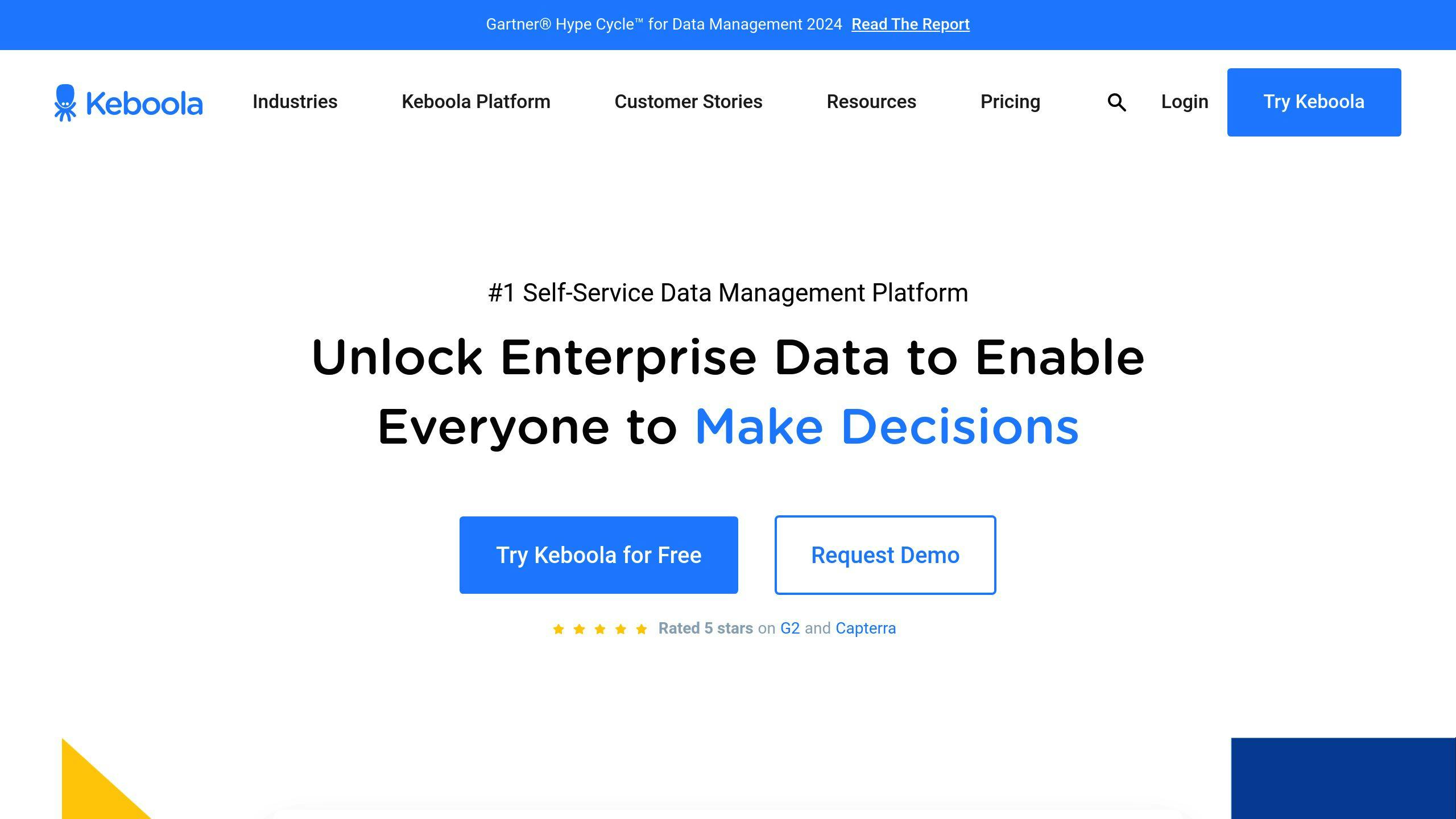
Keboola is turning heads in data orchestration with its all-in-one platform. It's not just another tool - it's a complete solution for data integration, transformation, and automation.
Think of Keboola as a Swiss Army knife for data teams. It handles everything from ETL processes to machine learning workflows. But here's the kicker: you can start a data project in under a minute. That's FAST.
With over 700 integrations, you're not likely to hit a snag connecting your favorite tools. But Keboola isn't just for the coding pros. It's got a no-code interface that lets business users dive into data without calling IT. This is huge for companies wanting to build a data-driven culture.
Don't just take my word for it. Here's what Jakub Zalio, Group CTO at Creditinfo Group, says:
"Keboola's solution has transformed our approach to data, making it a crucial part of our daily operations."
Keboola is also future-proofing businesses. Their platform is designed to make companies "AI-ready" - a big deal as more businesses eye artificial intelligence.
Worried about security? Keboola's got you covered with enterprise-grade features and various deployment options, including fully managed and single-tenant.
Their new Data Streams feature is a game-changer. It allows real-time data integration through Webhooks. For e-commerce, this means up-to-the-minute sales and customer data, enabling quick operational shifts.
Keboola's pricing is smart, too. They offer a free-forever plan for core features. As you grow, you pay for what you use - perfect for startups and scale-ups.
In the data orchestration race, Keboola is positioning itself as the go-to platform for businesses wanting to harness their data without getting stuck in technical weeds. Keep an eye on this one - it might just be the ace up your sleeve in 2024.
Conclusion
We've looked at the top 10 data orchestration tools for 2024. These tools are changing how companies handle their data workflows. From Apache Airflow to Keboola, each tool has its own strengths.
These tools have a big impact on how businesses work. Let's look at Molson Coors Beverage Company. They started using Astronomer's Apache Airflow on Azure. Here's what Kevin Schmidt, their Sr Manager of Data Engineering, said:
"Using Astro's Apache Airflow® offering on Azure has modernized our data operations. Their best-in-class SLAs, multi-environment deployments, and intuitive dashboards have streamlined our processes, ensuring we can manage our critical pipelines."
This shows how these tools can help in real life.
The money side looks good too. Astronomer users saw a 438% ROI in less than 6 months. They also spent 75% less time on infrastructure management. This means these tools can save time and money.
But it's not just about saving money. These tools help businesses use their data better. They automate complex tasks, so data teams can focus on finding insights instead of managing systems. This is important because over 87% of businesses struggle to use their data well due to information silos and complexity.
Looking ahead, AI and machine learning are joining forces with data orchestration. Databricks is leading this charge. This is crucial as 3 out of 4 executives say unreliable data is their biggest AI challenge.
If you're thinking about using these tools, here are some tips:
1. Start small, grow big
Begin with a tool that fits your needs now but can grow with you. Apache Airflow and Prefect are good starting points.
2. Make sure it works with your other tools
Choose tools that play nice with what you already use. Endgrate's single API for over 100 integrations is a good example.
3. Focus on good data
Tools like Dagster, which focus on data quality and testing, can help ensure your data is reliable.
4. Use automation
Look for tools that automate repetitive tasks. AWS Glue's serverless approach shows how automation can reduce work.
5. Think about AI
As AI becomes more important, tools like Keboola that help companies get "AI-ready" will be valuable.
FAQs
What is the best ETL orchestrator?
There's no one-size-fits-all answer, but Apache Airflow is a standout ETL orchestrator. It's open-source, Python-based, and uses Directed Acyclic Graphs (DAGs) to schedule and automate data workflows.
Why is Airflow so popular? It's flexible, scalable, and plays nice with lots of third-party tools. Big names like Airbnb use it for their complex data pipelines.
Here's what Pedram Navid, Head of Data at Hightouch, has to say:
"Without a doubt, Airflow is a project that has been around for over a decade, has the support of the Apache Foundation, is entirely open-source, and used by thousands of companies is a project worth considering. In many ways, going with Airflow is the safest option out there
But remember, the "best" tool depends on what you need. Think about your team size, how much data you're dealing with, and what other tools you need to connect to when picking an ETL orchestrator.
What are the various tools used in ETL?
The ETL world is packed with tools for all sorts of needs and skill levels. Here's a quick tour of some popular options:
Apache Airflow is the open-source darling, perfect for Python fans and complex workflows. If you need tons of integrations, Keboola might be your go-to with over 100 ready-to-use connections.
For the Java crowd, Talend Open Studio offers a graphical interface and open-source flexibility. Microsoft fans might lean towards SQL Server Integration Services (SSIS), which fits snugly in the Microsoft ecosystem.
Big enterprises often turn to heavy-hitters like IBM InfoSphere DataStage for high-volume data integration, or Oracle Data Integrator for Oracle-centric setups.
Don't forget about Pentaho Data Integration if you want an open-source tool with a visual designer. And for those dealing with massive data sets across clusters, Hadoop is still a go-to solution.
Each tool has its sweet spot. Airflow shines for Python-savvy teams, while Keboola might be the ticket for those who want a user-friendly interface with lots of pre-built connectors. It's all about finding the right fit for your data needs.
Related posts
Ready to get started?
